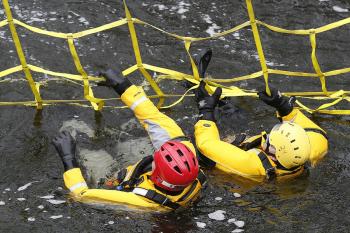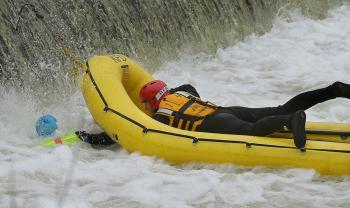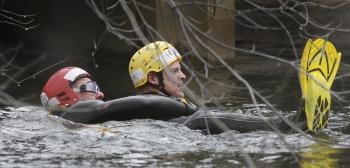Preparing for Swiftwater Rescue Incidents
NFPA 1670
by Gerald M. Dworkin
04/10/09




In February 2004, the National Fire Protection Association (NFPA) published NFPA 1670: Standard on Operations and Training for Technical Search and Rescue (SAR) Incidents. The purpose of this standard was to minimize threats to rescuers while conducting operations at technical SAR incidents. This standard deals specifically with identifying and establishing levels of functional capability for conducting technical rescue operations safely and effectively.
This standard was intended to assist the Authority Having Jurisdiction (AHJ) to:
1. Assess the technical rescue hazard within their specific response area;
2. Identify the level of operational capability needed; and
3. Establish operational criteria.
According to NFPA 1670, the AHJ shall establish levels of operational capability (i.e. Awareness, Operations, and/or Technician) needed to conduct operations at technical SAR incidents safely and effectively, based on hazard identification, risk assessment, training level of personnel, and availability of internal and external resources. Once the operational level has been identified, the AHJ shall establish operational procedures, Standard Operating Procedures (SOPs) and Emergency Response Plans (ERPs), consistent with the identified level of operational capability to ensure that technical SAR operations are performed in a manner that minimizes threats to rescuers and others. The AHJ must then provide for training in the responsibilities that are commensurate with the operational capability of the organization, and provide for the continuing education necessary to maintain all requirements of the organization’s identified level of operational capability. Therefore, after determining the level of response and technical capability the authority is compelled to provide, the AHJ must then plan for it, train for it, and allocate the necessary resources (both personnel and equipment) to manage the appropriate response at that level.
NFPA 1670 does not require the AHJ to immediately purchase a lot of expensive equipment or assemble technician-level teams. There is nothing wrong with the authority training personnel and operating at the Awareness or Operations level, as long as they arrange for the response of external resources if they are not going to handle the SAR incident themselves. Emphasis on Awareness issues ensures that critical elements of the scene will be managed appropriately by all personnel, not just the technical rescue team. Safety issues are addressed, resource needs are identified, and the technical team can do the work instead of managing the scene. Therefore, all AHJs must conduct a threat assessment within its community and jurisdiction to assess the needs of the community and prepare its teams to the appropriate level of operational capability.
LESSONS LEARNED
The Keene Fire Department first identified swiftwater rescue as a low frequency/high risk incident type in the Spring of 2000 when they were confronted with a motor vehicle incident involving a vehicle, with an ill and injured trapped victim, in the middle of a fast moving river. Although the department had training and equipment to respond to cold water and ice rescue incidents, they had no training or equipment for response to swiftwater rescue incidents. According to Deputy Chief Boynton, “after two failed attempts using cold water immersion suits that nearly drowned two of our personnel, we adapted and managed to rescue the subject.”
During the next five years, the Department developed a comprehensive Threat Assessment and Swiftwater Rescue Response Plan and acquired the funding to train all full-time personnel to safely and effectively respond to swiftwater incidents, with a particular concern for the high risk associated with a response to incidents involving a hydraulic below the low-head dam on the Asheulot River in the center of Keene. This specific hazard generates a very dangerous hydraulic that is almost impossible to escape. During the past several years, the Keene Fire Department has pulled 3 victims from the hydraulic below the lowhead dam.
In 2004, a kayaker attempted to paddle over the lowhead dam and became trapped in the hydraulic below the dam. The Fire Department was faced with the difficult and dangerous mission of negotiating the current of the river to rescue the victim without endangering their own personnel to do so. Luckily, as Fire Rescue personnel arrived on scene, the limp body of the kayaker was released from the hydraulic of the dam and rescue personnel were able to successfully resuscitate him.
In April 2005, Lifesaving Resources was contracted by the department to train all 43 full-time personnel in swiftwater rescue. The goal was to train all personnel and acquire the equipment that would be required to properly execute a rescue in swiftwater and from the hydraulic below the lowhead dam. Several months later, during the Fall of 2005, their training was put to the test when the City of Keene experienced severe flooding when more than 10 inches of rain fell in less than 24 hours resulting in flooding in about 70% of the city.
Over the next several years, equipment was purchased with funding from donations, federal and state grants, and equipment budgets. In 2008 their skills were once again put to the test on two occasions.
On April 6th, the Keene Fire Department was dispatched to the Ashuelot River when a kayaker was pulled into the hydraulic below the low head dam when he paddled in front of the dam to have his picture taken by his girlfriend. As rescue crews arrived, they found a lifeless body that had washed out of the dam after drowning. Miraculously, the rescue crews managed to resuscitate the victim and he fully recovered.
On April 18th, the Keene Fire Department was again dispatched to the Ashuelot River for two subjects caught in the hydraulic below the lowhead dam after they attempted to run the falls in a small inflated swimming pool. D-shift responded with Rescue 1, Ambulance 2, the on-call chief, and a call went out to all off-duty personnel to report to the scene for additional manpower. Within 9 minutes of arrival, Fire Department personnel donned rescue dry suits, deployed their rescue boat, and paddled approximately 100 yards upstream to pull the victim from the falls just seconds after he became too exhausted to hold onto his raft. He was transported to shore and treated for extreme hypothermia and exhaustion, and has since made a full recovery. According to Deputy Fire Chief Mark Boynton, “rescue crews had to overcome extremely swift currents, nearly 100 bystanders, and a woman who jumped in the ice cold water thinking she could help the victim, and needed rescue herself.”
SWIFTWATER RESCUE TRAINING & EQUIPMENT
NFPA 1670 establishes the need for the AHJ to plan for the incident, train for the incident, and acquire the resources required to safely and effectively respond to and manage the incident. A critical component for any response to a Swiftwater Rescue incident is the Personal Protective Equipment (PPE) required for rescue personnel. This equipment includes a Personal Flotation Device (PFD) that is specifically designed for swiftwater rescue operations; a wetsuit or drysuit (with fleecewear) ; wetsuit booties; water rescue gloves; and a helmet. Other PPE equipment can include swiftwater rescue fins and goggles.
In order to gain access to the victim to affect the rescue, specialized rescue equipment may be required, depending upon the threat assessment conducted by the AHJ. This specialized equipment can include boats, rescue curtains, rescue lines, throw bags, line-deploying devices, etc.
And, in order to use this equipment effectively, incidents must be pre-planned and all personnel must be appropriately trained to safely and effectively use their PPE, their specialized rescue equipment, and to adhere to their established SOPs, and to implement their Emergency Response Plans. Therefore, training is absolutely critical.
In April 2009, Lifesaving Resources once again conducted training for the full-time Keene Firefighters. A pre-plan was developed for incidents involving victims trapped in the hydraulic below the lowhead dam on the Ashuelot River. After a day of training, firefighters were able to implement this plan that resulted in their ability to don their PPE, deploy their equipment, and effect a rescue in under 6 minutes from time of arrival on the scene.
This has taken a lot of research, planning, and work by the Keene Fire Department, their chief officers, and their personnel – but with tremendous results. The department has purchased a number of PPE sets to safeguard their personnel; they’ve conducted continuous training; and they’ve purchased specialized rescue equipment for shore-based and in-water rescue. According to Mark Howard, Deputy Fire Chief for Operations, “All of this has been a dynamic process over the past 5 years with immediate results. Last year we had two different rescues in which three people were pulled from the hydraulic below the low head dam – one of which was in cardiac arrest who was successfully resuscitated by Keene Fire Department and EMS personnel on scene.”
Photos by Steve Hooper of the Keene Sentinel taken April 06 & 08, 2009
ABOUT THE AUTHOR
Gerald Dworkin is a professional Aquatics Safety and Water Rescue Consultant for Lifesaving Resources (lifesaving.com). He is responsible for the development of Aquatics Safety, Lifeguarding, Water Rescue, Swiftwater Rescue, and Ice Rescue training curriculums and educational materials, including the course guidebooks, powerpoint presentations, etc. Dworkin has been a career, call and/or volunteer firefighter and EMT for over 30 years, and is currently a Firefighter/EMT with the Harrisville Fire Rescue Department in New Hampshire. Dworkin has consulted for and appeared on numerous national media programs including CNN; MSNBC News; ABC’s Good Morning America; CBS’ Early Show; NBC’s Today Show; The Discovery Channel; the G. Gordon Liddy Show; and Fire Emergency Training Network (FETN). Dworkin has published over 40 articles and has presented at numerous Fire, Rescue, EMS, and Aquatic Conferences throughout the United States. Dworkin also regularly consults as a Forensics Expert in drowning and aquatic injury litigation.
PHOTOS
Photos taken by Steve Hooper of the Keene Sentinel.
Top
Dworkin explaining low-head dam rescue procedures to Keene Firefighters.
Second
Firefighters being swept into downstream Rescue Curtain which is strung across the river as a downstream safety backup. Information on the Rescue Curtain can be found within the Lifesaving Resources’ OnLine Catalog.
Third
Firefighter is advanced to face of low head dam to retrieve a simulated victim caught in the hydraulic of the dam.
Bottom
Firefighter rescues simulated victim during Live Bait Swimming Rescue evolution.


